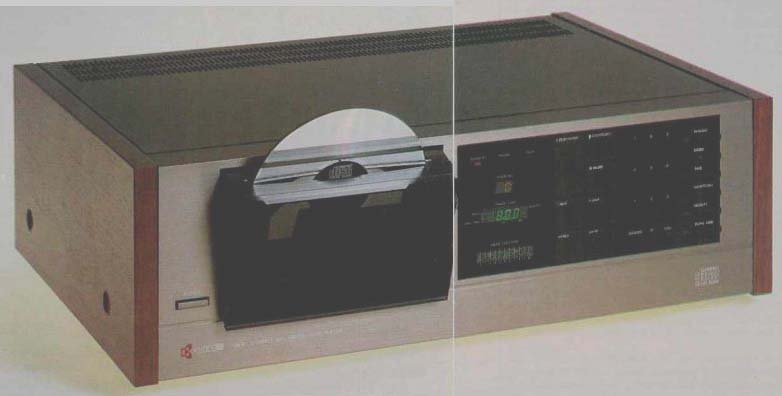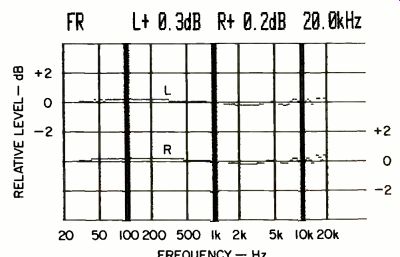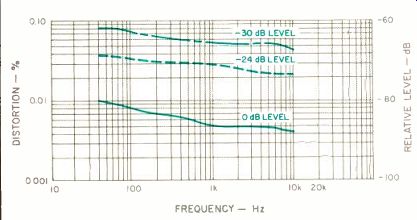
Manufacturer's Specifications:
Frequency Response: 20 Hz to 20 kHz. ±0.5 dB.
Dynamic Range: Greater than 90 dB.
S/N Ratio: Greater than 90 dB.
Channel Separation: Greater than 90 dB at 1 kHz.
Harmonic Distortion: Less than 0.005% at 1 kHz.
Wow and Flutter: Unmeasurable (a function of quartz crystal tolerance).
Audio Output Level: 2.0 V rms.
Power Consumption: 120 V, 60 Hz, 30 watts.
Dimensions: 18 1/4 in. (46.4 cm) W x 5 1/4 in. (13.3 cm) H x 12 5/8 in. (31.9 cm) D.
Weight: 18 1/2 lbs. (8.4 kg.)
Price: $1,050.00.
Company Address: 7 Powder Horn Dr., Warren, N.J. 07060.
The Kyocera DA-01 Compact Disc player is a substantial-looking machine, almost as large as an integrated amplifier or a complete receiver. In fact, equipped as it is with wood side panels and a very attractive, gun-metal colored front panel, the unit could easily be mistaken for a full-featured cassette deck or receiver. The unit has a swing-down hinged door which, when opened, discloses a narrow slot into which a Compact Disc is placed, label facing outward.
On the Kyocera, unlike earlier models with similar loading techniques that I have tested, one pushes the disc all the way down into the door, then closes the door manually, much as one would with a front-loading cassette-compartment door. In this, and some other respects, the Kyocera DA-01 is similar in layout to the Phase Linear 9500.
The power on/off switch of this player is located to the left of the disc-compartment door. To the right of this door is a display area which provides a wealth of information about the disc being played. A ruler-like scale with a moving LED behind it tells approximately how far into a record the laser pickup has progressed. A digital readout displays time into the given track being played or total time from the start of a disc, depending upon whether or not a "Total Time" touch button (located elsewhere) is depressed. Surrounding this time display are tiny LED indicators which light up when total time is being displayed, when the programmed selections are being played in selected order, and when a separate "Index" button is touched. (More about the "Index" function in a moment.) A separate digital display shows the current track being played or selected. Three more indicator lights along the top of the display area show whether the Kyocera DA-01 player is in "Standby," "Pause," or "Play" mode.
Basic operation of the player is handled by seven large touch-pads, the largest of which is labeled "Play/Start." A "Stop/Eject" button terminates play if a disc is playing or, pressed a second time, opens the disc door and ejects the disc from the door slot enough so that it can be removed.
The "Pause" control interrupts play but keeps the laser pickup precisely at the point of interruption. Touching the "Pause" button again causes play to resume. Forward and reverse "Skip" buttons, when touched, move the laser to the start of the next or previous selection on a disc. Fast-forward and reverse buttons, when held in their depressed positions, move the laser pickup rapidly in either direction while the track and time displays follow the movement, allowing you to start playing at any predetermined track or time into the track.
To the right of these large touch-pads are smaller numbered keys, from 0 to 9. which, when used in conjunction with the "Memory" and "C/AC" (Clear/All Clear) keys, allow you to pre-program a sequence of selections in any order you choose. Some of the most innovative convenience features I have yet encountered on any CD player are activated by the last series of touch buttons, located at the extreme right of the front panel. When the uppermost of these, labeled "Phrase," is touched once, a "mark" is set for the particular location then being played. If the button is touched a second time later on in the disc, the player repeats the section from the first "mark" to the second one, over and over again, until the order is cancelled with the All-Clear button. This proved to be extremely useful in my study of the player when I wanted to hear a musical phrase (or section of a test tone) over and over again for careful analysis and study.
The second button in this row of switches is identified as "Index." I am told that, in the future, some Compact Discs (particularly classical works which have very long selections, such as complete movements as a single "track" number) may have additional "index" codes within each track. These codes would be listed on the disc's jacket and could be accessed when you want to hear a particular portion of a long track. If discs encoded with index points are played, and if these are called up by the user, the track display continues to indicate the selected track, while the time display switches from a "minutes:seconds" arrangement to a two-digit representation of the "Index" number called for.
The third button in this group, labeled "Time," may be used to access any amount of time into a given track of a disc. Using the numeric keypad, you first punch in the track number and then the time, in minutes and seconds. After that the "Time" button is depressed, to let the microprocessor know that you not only want a given track but a given amount of time into that track. Next, press "Play/Start"-or "Memory," if you want to program several such access points in sequence.
A "Memo Call" button reviews all of the track numbers you have programmed into memory for sequential programming. by flashing each of them on the track display for a couple of seconds. A "Repeat" button is used for playing any given track, or even a complete disc, over and over again. The last button in this group is the "Total Time" button whose function I have already mentioned.
The rear panel of the DA-01 is equipped with the usual left and right output jacks and an output level control.
Measurements
Beginning with this CD player test report, I am using two new test discs supplied by Philips. The first of these contains a wide variety of test signals which permit a much more comprehensive series of measurements to be made than is possible with the Sony test disc I have been using up to now. (I'll explain the contents of this disc as I discuss the measurement results.) The second disc contains some 25 different classical and popular musical excerpts, but super imposed upon the surface of this second disc, between selection 3 and selection 9, is an opaque wedge which gets progressively wider towards the outer perimeter of the disc (remember, CD discs are played from inside to outside).
This wedge is used to check a player's error-detection and error-correction facilities. A player that can play all the way through track 9, without interrupting play or repeating tracks over and over again with each revolution of the disc, can handle information interruptions that are 900 micrometers long (the widest dimension of the wedge).
Between tracks 10 and 15 are four black dots of increasingly large diameter painted on the surface of the disc.
These are meant to simulate increasingly large dust particles on a disc. If the system can play through this sequence successfully, its error-correction system has managed to handle a "dust particle" that is 800 microns in diameter.
Finally, near the outside edge of the test disc, there is a semi-opaque area that is supposed to simulate a fingerprint on the surface of the disc.

Fig. 1-Frequency response, left channel (top curve) and right channel
(bottom curve).

Fig. 2-THD vs. frequency, at three output levels.

Fig. 3 Square-wave reproduction, 1 kHz.
Fig. 4 Single-pulse test; note ringing.
Fig. 5 Two-tone phase test (2 kHz in one channel, 20 kHz in the other; see text).
The first test signals contained on the nonmusical disc are frequency response sweeps, extending from 20 Hz to 20 kHz. The sweeps are slow enough for my test instrument to "track" at all but the very lowest frequencies, which are never a problem on CD players in any case. Accordingly, I was able to "plot" response completely electronically, and to expand the vertical sensitivity of the resulting graph so that one division is equal to 2 dB, instead of the usual 10 dB. Both left- and right-channel responses are shown in Fig. 1.
With the electronic cursor set to 20 kHz, I read a maximum deviation of only +0.3 dB for the left channel and +0.2 dB for the right channel. To the best of my recollection, this is the first CD player in which the low-pass filter was so precisely adjusted that not only was there no measurable attenuation of response at 20 kHz, but it actually exhibited a very slight rise in response at that frequency.
Several tracks of the Philips test disc are for measurement of total harmonic distortion, not only at mid-frequencies, but over a wide range of frequencies from 41 Hz to 20 kHz.
Furthermore, recognizing that, in a digital audio system, best distortion figures are obtained relative to maximum (0 dB) levels, Philips supplies a series of test tones at -24 and at -30 dB so that the tester can measure how THD rises with decreasing signal levels. The three curves of Fig. 2 are therefore much more informative than any data I have been able to supply before. They show THD versus frequency at three different output levels from the player. At mid-frequencies, THD did indeed measure its claimed 0.005%, providing the reference was maximum output. At lower recording levels, however, notice that THD increases, although even at a-30 dB level it was still inaudible, with readings of 0.055%. Because results were virtually identical for the left and right channels, I have not shown two separate sets of curves.
Signals are provided on the test disc at 997 Hz for checking linearity of the playback system. (The odd choice of frequency has to do with avoiding sub-multiples of the sampling rate, 44.1 kHz.) Levels are 0, -1, - 6, -12, - 24, -60,-80, and -90 dB. I detected no significant deviation from perfect linearity until the test got down to -80 dB, which my instrument read as -77.6 dB. I suspect that this was not so much a matter of nonlinearity as my test setup beginning to combine noise readings with actual 997-Hz signal readings. Again, results were identical for both channels tested.
The Philips test disc includes two tracks for checking SMPTE IM. With these, I measured 0.016% IM at 0 dB level and 0.06% at a-20 dB record level. Signal-to-noise ratio measured exactly 90 dB with reference to 0 dB (maximum) output level, unweighted. With an A-weighting filter inserted in the signal path to the meter, S/N increased to 97 dB.
Much has been said in print about the effect of sharp cutoff filters in CD players. In the new test disc, Philips gives us several ways to judge the effect of the ultrasonic filters designed into any CD player. Square waves at frequencies of 100 Hz, 400 Hz, 1 kHz and 5 kHz are provided, as are various tone bursts, pulse signals and phase-checking pairs of signals. I found that the 1-kHz square-wave signal is a good one to display (see Fig. 3), since it clearly shows the degree of "ringing" that is produced by the sharp cutoff filter found in this and other players. Judging by other CD players I have tested, it would be fair to say that the square waves of Fig. 3, as reproduced by the Kyocera DA-01, exhibit less ringing than usual. This is no doubt attributable to Kyocera's use of double filtering. A digital filter system is used prior to D/A conversion, thereby enabling the use of a more gentle, analog low-pass filter following the D/A converter in each channel's signal path. As you will see in future reports of this kind, there will be noticeable differences in the amount and nature of this ringing from one design to another.
One of the single pulses incorporated in the Philips discs consists of a single "sample" at full scale, followed by 127 samples at "zero amplitude." As you can see from Fig. 4, this test signal was reproduced with a fair amount of ringing, in both positive and negative polarity, following the unit pulse itself. Again, watch upcoming reports to see how this compares with pulse reproduction from other CD players.
Although there are several phase-check test signals on the new test discs (these are generally of a form where results from one channel are compared with results from the other), the most significant one, to my way of thinking, is one in which a 2-kHz signal is recorded on one channel while a 20-kHz signal is recorded on the other. The notes for the test record say that the positive-going crossing of the zero axis of the lower-frequency signal is supposed to occur at the same instant that the higher-frequency signal crosses the zero axis in the same direction. If you examine the two sine waves in Fig. 5 carefully, you will notice that, in fact, the low-frequency signal crosses the zero axis in a positive-going direction when the high-frequency signal crosses the zero axis in a negative direction. This means that the high-frequency signal is displaced relative to the mid-frequency signal by 180°, which works out to be a phase-error time delay of at least 25 ILS (one-half the duration of one cycle of a 20-kHz signal).
Using the musical test disc with the opaque wedge, the "black dot" dust simulations and the fingerprint simulation, I was pleased to note that the Kyocera unit played right through all of the tracks covered by the wedge. In other words, error correction took place over linear distances as great as 900 microns. The system was bothered, however, by the third black dot (second from the largest one), which had a diameter of 600 microns. During the track containing this "defect," there was occasional "skipping," almost as if I was playing a record with a repeating groove, to use a familiar analog-y. As for the fingerprint simulation, the Kyocera DA-01's laser pickup ignored it completely, playing right through the selections that were marred by this defect as if it weren't even there.
Use and Listening Tests
Now that you've seen just how much phase shift takes place at high frequencies with a CD player of this type, and just how much "ringing" is evident in a 1-kHz square wave reproduced from a test disc, you are probably wondering if my unqualified enthusiasm for the CD format has in any way been dampened. Well, it hasn't! I still think that, all things considered, the sound I get from a digitally mastered CD reproduced over a high-quality audio system is better than I've experienced from any other program source in the three decades during which I've been involved with audio equipment. The Kyocera player is no exception. It performed reliably throughout the several days during which it became my primary program source. Its "access" features (ability to get to a certain point in the music) are well engineered and relatively easy to use and understand.
My disc collection keeps getting better, and I'm beginning to weed out some of the poorer recordings which, I still believe, do not fully utilize the potential of the digital disc medium. As I find better and better discs with which to test CD players, the units themselves seem to sound better and better. I expect it won't be long now before the source material gets so good that I'll be able to hear the subtle differences between players that I'm now able to detect only by measurement. Until that time comes, I will continue to praise CD players as I encounter them, and not try to rank one above another except in terms of operating and convenience features. In those terms, and considering its price, the Kyocera ranks high on my list of favorites.
-Leonard Feldman
(adapted from Audio magazine, Aug. 1983)
Also see:
Kyocera DA-710CX CD player (Equip. Profile, Aug. 1987)
Kyocera R-851 Tuner-Amp (May 1983)
Mitsubishi DP-101 Compact Disc Player (Aug. 1983)
= = = =